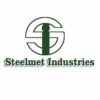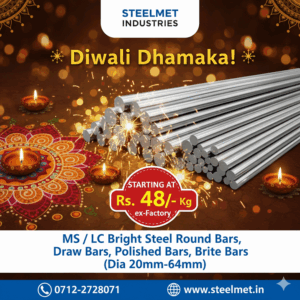In the world of precision engineering, surface finish, straightness, and machinability play a critical role in the performance of steel bars. Two common choices are Peeled (Turned) Bars and Cold Drawn Bright Bars. While both deliver enhanced dimensional accuracy compared to hot rolled black bars, their behavior differs when processed across different steel grades — low carbon, medium carbon, high carbon, free-cutting steels, alloy steels, and spring steels.
At Steelmet Industries, we specialize in supplying precision-engineered bars to meet exacting requirements across industries. This post compares Peeled vs. Cold Drawn Bright Bars and evaluates the ease of straightening and processing across steel grades.
1. Peeled (Turned) Bars vs Cold Drawn Bright Bars – Key Differences
| Feature | Peeled / Turned Bars | Cold Drawn Bright Bars |
|---|---|---|
| Straightness | Good, but depends on grade & diameter | Excellent due to cold drawing + straightening |
| Surface Finish | Smooth, defect-free (removes scale) | Bright, polished finish |
| Dimensional Tolerance | Close, but not as tight as bright bars | Very tight tolerance achievable |
| Residual Stress | Minimal (machined off surface) | Higher due to cold work, may need stress relieving |
| Machinability | Very good, especially in free-cutting steels | Excellent, but may vary by grade |
| Cost | Higher due to machining process | More economical for mass production |
2. Straightening Ability by Steel Class
Straightening behavior differs significantly between steel grades. Here’s a ranking from easiest to most difficult to straighten:
| Steel Class | Ease of Straightening | Reason |
|---|---|---|
| Low Carbon Steels | ★★★★★ (Easiest) | Soft, ductile, low resistance to cold work |
| Free-Cutting Steels | ★★★★☆ | Added sulfur/lead improve machinability, but slight brittleness affects correction |
| Medium Carbon Steels | ★★★☆☆ | Balanced strength & ductility; moderate resistance to bending |
| Alloy Steels | ★★☆☆☆ | Higher strength from alloying makes them stiffer |
| High Carbon Steels | ★★☆☆☆ | Harder, less ductile, prone to spring-back after straightening |
| Spring Steels | ★☆☆☆☆ (Most Difficult) | High tensile strength & elasticity resist straightening |
3. Peeled vs. Cold Drawn Bars in Different Steels
| Steel Class | Peeled / Turned Bars | Cold Drawn Bright Bars |
|---|---|---|
| Low Carbon Steels | Good straightness, smooth finish | Excellent straightness, very tight tolerances |
| Medium Carbon Steels | Good for machining, manageable straightness | Superior straightness but more effort needed |
| High Carbon Steels | Less distortion risk vs cold drawing | Can be tough to straighten due to hardness |
| Free-Cutting Steels | Excellent machinability, good finish | High precision possible, may need stress relief |
| Alloy Steels | Dimensional stability, moderate straightness | Stronger, more challenging to straighten |
| Spring Steels | Peeled preferred (less stress issues) | Very difficult to cold draw & straighten |
4. Which Should You Choose?
If surface removal of defects (scale, decarburization) is a priority → Peeled Bars are ideal.
If high straightness and dimensional tolerance are crucial → Cold Drawn Bright Bars are the better choice.
For tough steels (spring, high carbon, alloy steels) → Peeled Bars often perform better due to reduced residual stresses.
Conclusion & CTA
Choosing between Peeled (Turned) Bars and Cold Drawn Bright Bars depends on the steel grade and your end-use application. For easier grades like low carbon steels, bright bars provide unmatched straightness. But for tougher materials like spring or high-carbon steels, peeled bars often prove more reliable.
At Steelmet Industries, we supply both Peeled and Cold Drawn Bright Bars, customized to your industry’s needs with precision straightening, tight tolerances, and reliable performance.
👉 Contact us today at Steelmet Industries to discuss the best solution for your requirements.


